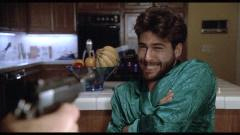Vinegar Syndrome's limited edition Blu-ray boxed set AMITYVILLE: THE
CURSED COLLECTION proves that America's most haunted property still has buyers.
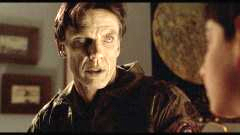
After AMITYVILLE 3D, hapless families finally took the hint not to
buy a cheap house built over an Indian burial ground where a mass murder occurred;
however, no one can pass up a bargain, and author John G. Jones gave readers
"Amityville: The Evil Escapes" an anthology of short stories in which
buyers of objects from the house in a yard sale take the evil home with them.
Former New World Pictures President of Production Steve White (CABIN BOY) and
partner Barry Bernardi (ESCAPE FROM NEW YORK) could not pass up a deal either
and bought the rights to the book cheaply and THE AMITYVILLE HORROR screenwriter
Sandor Stern took the basic concept and scripted AMITYVILLE: THE EVIL ESCAPES
as a television movie for NBC in 1989 in which a six priest exorcism of the
house – lead by Father Manfred (Norman Lloyd, SPELLBOUND) – causes
the evil to escape through the electrical outlets into a strangely humanoid-looking
lamp which is bought in a yard sale by Helen Royce (DAYS OF OUR LIVES' Peggy
McCay) and sent across the country as a macabre gift to her sister Alice Leacock
(FATHER KNOWS BEST's Jane Wyatt) whose house is about to be invaded by her recently-widowed
daughter Nancy (SHE WAITS' Patty Duke) and her children Amanda (Zoe Trilling,
TOBE HOOPER'S NIGHT TERRORS), Brian (Aron Eisenberg, PLAYROOM), and young Jessica
(Brandy Gold, WILDCATS). Jessica still has not gotten over her father's sudden
death and is drawn to the strange lamp which the others find ugly, and Nancy
goes from overhearing her daughter carrying on conversations with it to having
her own hallucinations of her late husband's apparition. The lamp causes the
household electronics and plumbing to go haywire sewing suspicion and resentment
between Alice, her daughter, and her grandchildren. Father Kibble (Fredric Lehne,
ORDINARY PEOPLE), who witnessed the evil escape into the lamp, discovers that
Helen has died of a severe strain of tetanus after cutting her finger on the
lamp and traces it to California where he hopes to keep it from its ultimate
goal of possessing the weakest member of the family.
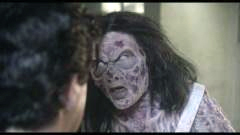 A
big event when it premiered on NBC, AMITYVILLE: THE EVIL ESCAPES falls short
of some of the other made-for-TV haunted house movies of the period like HAUNTED
and GRAVE SECRETS which also featured Duke. The lamp is a striking creation
and the new house also has some atmosphere, but television standards and practices
mostly reins in the film's violent and scary content. While I have never found
Wyatt particularly believable, even in her classic film and TV roles, here her
mannerly delivery and coolness suit the character who is called out for her
standoffishness towards her own grandchildren and believably transforms into
a "tough old lady" during the climax. The film was edited by Skip
Schoolnik (HALLOWEEN II) who had made his directorial debut with the slasher
HIDE AND GO SHRIEK the previous year and would go on to a prolific career as
a television producer with series like ANGEL, THE WALKING DEAD, and SALEM. Author
Jones is credited as associate producer.
A
big event when it premiered on NBC, AMITYVILLE: THE EVIL ESCAPES falls short
of some of the other made-for-TV haunted house movies of the period like HAUNTED
and GRAVE SECRETS which also featured Duke. The lamp is a striking creation
and the new house also has some atmosphere, but television standards and practices
mostly reins in the film's violent and scary content. While I have never found
Wyatt particularly believable, even in her classic film and TV roles, here her
mannerly delivery and coolness suit the character who is called out for her
standoffishness towards her own grandchildren and believably transforms into
a "tough old lady" during the climax. The film was edited by Skip
Schoolnik (HALLOWEEN II) who had made his directorial debut with the slasher
HIDE AND GO SHRIEK the previous year and would go on to a prolific career as
a television producer with series like ANGEL, THE WALKING DEAD, and SALEM. Author
Jones is credited as associate producer.
In AMITYVILLE 1992: IT'S ABOUT TIME, Jacob Sterling (Stephen Macht,
THE MONSTER SQUAD) is an architect who returns from breaking ground on a development
on the East Coast to Burlwood, California, where he lives in one of the luxury
units of his previous tract housing project, with a gift for his family –
troubled son Rusty (Damon Martin, GHOULIES II) and awkward daughter Lisa (DARK
SKIES' Megan Ward) who were being babysat by his ex-girlfriend Andrea (Shawn
Weatherly, SHADOWZONE) – in the form of a hideous antique clock which
at night drills itself into the walls of the house and quickly demonstrates
its ability to manipulate time by transforming the living room into a much older
room before Rusty's eyes. Far from frightened, Rusty and his occultist neighbor
Iris (Nita Talbot, FRIGHTMARE) are intrigued and look into the history of the
clock. After Jacob is attacked and has a chunk taken out of his thigh by a neighbor's
dog which suddenly turns vicious, he becomes obsessed with developing a timeless
new look for the houses on the East Coast lot and Iris discovers a picture that
reveals that the clock once sat on the mantle in the Amityville murder house
and where it had been before that was even worse. People who try to warn the
family meet with freak accidents while Rusty loses time inside the house, Lisa
goes from awkward to seductive and murderous, Jacob goes full psychopath, and
Andrea's psychiatrist new boyfriend Leonard (Jonathan Penner, LET THE DEVIL
WEAR BLACK) reaches farther for logical explanations than the shrink in POLTERGEIST
III.
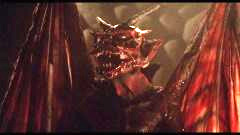
Helmed by Tony Randel early on in his direct-to-video period after
leaving New World Pictures where he had served as an editor and made his directorial
debut with HELLBOUND: HELLRAISER II, AMITYVILLE 1992: IT'S ABOUT TIME is an
improvement over the previous film with its combination of Gothic elements in
bland suburbia where a housing development does not foster community but rather
isolates families from their closest neighbors – Dick Miller makes a cameo
as a neighbor in a dispute with Jacob about hedge height – and busybodies
are ready to point fingers when something out of the ordinary happens. The clock
is an attractive prop and the concept of its manipulation of time is interesting
even if it really does not tie in with anything else. The film drops the theories
about the haunting from the earlier entries, bringing in the legend of serial
murderer and "Bluebeard" influence Gilles de Rais to little effect.
As irritating as the Leonard character is, his armchair psychoanalysis of a
family he barely knows does not of course explain their current behavior but
it does suggest why it is so easy for an outside malevolent influence to attack
them. KNB's make-up effects look particularly rubbery throughout, a fact not
helped by the cinematography of Christopher Taylor (EVERY BREATH) which is at
its best in darker scenes with blue gels and gobo shadows but looking otherwise
flat, while the visual effects of the usually top-notch Peter Kuran (BEETLEJUICE)
suffer from budgetary restraints. The melodic scoring of Daniel Licht (BAD MOON)
cannot help but draw comparisons to Christopher Young's HELLRAISER scores even
if the orchestration is never a lush.
 AMITYVILLE:
A NEW GENERATION gets away from the suburban setting, choosing instead a not
yet gentrified downtown Los Angeles where modern artists have formed a colony
in a warehouse of loft apartments owned by Dick (David Naughton, AN AMERICAN
WEREWOLF IN LONDON) and Jane (Barbara Howard, FRIDAY THE 13TH: THE FINAL CHAPTER).
Needing money to pay the rent, photographer Keyes (STRANGER THINGS' Ross Partridge),
painter Suki (Julia Nickson-Soul, GLITCH!), and sculptor Paulie (Richard Roundtree,
SHAFT) try to convince Dick to let them use the living space for a show. Paulie
has an anarchic sculpture in mind, but Suki is unsure what to paint –
and is also distracted by relationship strife with boyfriend Ray (Robert Rusler,
VAMP) – and Keyes who favored still life and landscape suddenly develops
an interest in people when he catches a homeless man (Jack Orend, THE BLUES
BROTHERS) following him around town. He takes the man's photograph and pays
him in return, and the man insists he take an ornate mirror that he claims to
be a family heirloom as a gift. Suki is drawn to the mirror and puts it in her
space, and it exerts its evil influence on Ray and kills him in a manner that
Detective Clark (Terry O'Quinn, THE STEPFATHER) rules to be a drunken accident;
whereupon Suki is inspired to paint her inner demons, the paintings of which
she animates with a pulley system attached to a noose (guess where this is going).
Keyes starts having recurring nightmares from his childhood of a man gunning
down his family. After the homeless man turns up dead, Keyes still claims not
to know who he is but arranges to pay for a proper burial. When a clerical error
ends up with the headstone identifying the man as Keyes' "beloved father,"
Keyes – with Clark's help and the support of girlfriend Llanie (Lala Sloatman,
PUMP UP THE VOLUME) – looks into the man's murderous past and his own
connection to it. Meanwhile, the mirror continues to turn the creative passions
of those who gaze into it to murderous ends.
AMITYVILLE:
A NEW GENERATION gets away from the suburban setting, choosing instead a not
yet gentrified downtown Los Angeles where modern artists have formed a colony
in a warehouse of loft apartments owned by Dick (David Naughton, AN AMERICAN
WEREWOLF IN LONDON) and Jane (Barbara Howard, FRIDAY THE 13TH: THE FINAL CHAPTER).
Needing money to pay the rent, photographer Keyes (STRANGER THINGS' Ross Partridge),
painter Suki (Julia Nickson-Soul, GLITCH!), and sculptor Paulie (Richard Roundtree,
SHAFT) try to convince Dick to let them use the living space for a show. Paulie
has an anarchic sculpture in mind, but Suki is unsure what to paint –
and is also distracted by relationship strife with boyfriend Ray (Robert Rusler,
VAMP) – and Keyes who favored still life and landscape suddenly develops
an interest in people when he catches a homeless man (Jack Orend, THE BLUES
BROTHERS) following him around town. He takes the man's photograph and pays
him in return, and the man insists he take an ornate mirror that he claims to
be a family heirloom as a gift. Suki is drawn to the mirror and puts it in her
space, and it exerts its evil influence on Ray and kills him in a manner that
Detective Clark (Terry O'Quinn, THE STEPFATHER) rules to be a drunken accident;
whereupon Suki is inspired to paint her inner demons, the paintings of which
she animates with a pulley system attached to a noose (guess where this is going).
Keyes starts having recurring nightmares from his childhood of a man gunning
down his family. After the homeless man turns up dead, Keyes still claims not
to know who he is but arranges to pay for a proper burial. When a clerical error
ends up with the headstone identifying the man as Keyes' "beloved father,"
Keyes – with Clark's help and the support of girlfriend Llanie (Lala Sloatman,
PUMP UP THE VOLUME) – looks into the man's murderous past and his own
connection to it. Meanwhile, the mirror continues to turn the creative passions
of those who gaze into it to murderous ends.
The attempt to get the furthest away from the formula (but not really),
AMITYVILLE: A NEW GENERATION is probably the best of the series if only because
its differences are novel, from the downtown Los Angeles as Soho-like artists'
colony to the mirror which causes characters to externalize their inner demons
which then consume them. Partridge is one of the better leads, with his character's
sudden interest in people after establishing his use of humor to deflect anything
too personal leading to interesting character development and a compelling performance.
Nickson-Soul and Naughton are also good in their supporting bits while O'Quinn
has already here slipped into his post-THE STEPFATHER genre character actor
stage of his career while Lin Shaye had already done a handful of genre products
but would not enter that stage of her career until INSIDIOUS and beyond. The
film is the best-looking in set thanks to the photography of Wally Pfister who
had been paying his dues in the nineties mainly in erotic thrillers adult filmmaker
Gregory Dark was directing around the period under the name A. Gregory Hippolyte
like ANIMAL INSTINCTS, SECRET GAMES, and MIRROR IMAGES. Licht is back as composer
and seems to have been influenced by then-popular group Enigma's melding of
techno and Gregorian chant. Director John Murlowski is probably better known
for his obscure slasher debut RETURN OF THE FAMILY MAN than for the twenty-odd
direct-to-video films he has made since.

The last of the second cycle of films, AMITYVILLE DOLLHOUSE finally
comes home when architect Bill Martin (Robin Thomas, ABOUT LAST NIGHT) builds
a new house on the burnt-out remains of the Amityville house, centering around
the fireplace and chimney that survived the blaze. He seems to be the only one
excited about the move in his blended family of teenage son Todd (Allen Cutler,
CROSSCUT), young daughter Jessica (Rachel Duncan, RUMPLESTILTSKIN), new wife
Claire (Starr Andreeff, DANCE OF THE DAMNED), and nerdy stepson Jimmy (Jarrett
Lennon, SERVANTS OF TWILIGHT). Breaking into a nearby old shed on the property,
Bill discovers an ornate and very familiar-looking dollhouse, which is fortunate
when his truck takes on a mind of its own and crushes the bicycle he has purchased
for Jessica's birthday. Jessica loves the dollhouse but Bill's New Agey sister
Marla (Lenore Kasdorf, MISSING IN ACTION) and her occultist husband Tobias (Franc
Ross) get bad vibes from it. Jessica soon becomes afraid of the dollhouse as
it has the power to influence thing within the family's home, while a rapidly
decaying apparition of Jimmy's late father (Clayton Murray) tries to convince
him that Bill wants to take his mother away and that the boy will have to stop
him, Claire is compelled to sexual feelings for her stepson, and Todd's girlfriend
Dana (THAT 70S SHOW's Lisa Robyn Kelly) meets with a freak accident while getting
warm and toasty near the living room fireplace. Bill's own long-suppressed gift
of premonition reasserts itself in the form of dreams that combine the events
of the previous house's blaze with mounting sense of danger for his family.
 Coming
three years after AMITYVILLE: A NEW GENERATION with producer Steve White making
his directing debut for different producers, AMITYVILLE DOLLHOUSE is a hodgepodge
of concepts – is the titular dollhouse the portal for the evil force or
the surviving fireplace – with demons, voodoo dolls, zombies, demons,
insects, and the same old psychological deterioration of an already fractured
family. Performances range from fair to competent, with Lennon initially as
irritating as his weedy character until Jimmy not only questions what his father
is demanding of him but also realizing that he is being bullied. The family
drama seems more obligatory than compelling while the make-up effects work of
Ron Knyrim's Sota FX ranges from rubbery to effective (particularly with regard
to "dead dad"). Slipping back into the formula after A NEW GENERATION,
DOLLHOUSE just seems to be marking time and checking off concepts with only
the handsome photography of low budget genre great Tom Calloway (DEMON WIND)
to recommend. Despite the house ostensibly having been erected over the site
of the Amityville house, the hilly land around it looks less like upstate New
York and more like Southern California.
Coming
three years after AMITYVILLE: A NEW GENERATION with producer Steve White making
his directing debut for different producers, AMITYVILLE DOLLHOUSE is a hodgepodge
of concepts – is the titular dollhouse the portal for the evil force or
the surviving fireplace – with demons, voodoo dolls, zombies, demons,
insects, and the same old psychological deterioration of an already fractured
family. Performances range from fair to competent, with Lennon initially as
irritating as his weedy character until Jimmy not only questions what his father
is demanding of him but also realizing that he is being bullied. The family
drama seems more obligatory than compelling while the make-up effects work of
Ron Knyrim's Sota FX ranges from rubbery to effective (particularly with regard
to "dead dad"). Slipping back into the formula after A NEW GENERATION,
DOLLHOUSE just seems to be marking time and checking off concepts with only
the handsome photography of low budget genre great Tom Calloway (DEMON WIND)
to recommend. Despite the house ostensibly having been erected over the site
of the Amityville house, the hilly land around it looks less like upstate New
York and more like Southern California.

AMITYVILLE: THE EVIL ESCAPES premiered on television in May 1989 and
turned up on videotape and laserdisc in 1992 with an R-rating and some instances
of additional violence and gore – notably an accident involving a garbage
disposal and a teenage boy (director Stern's son Jamie, PIN) – and it
was this version that went to video and theatrical release in overseas territories,
as well as Sterling Entertainment's fullscreen 2007 DVD. Mastered from a 4K
scan of the original 35mm camera negative with the title AMITYVILLE HORROR:
THE EVIL ESCAPES, the film's 1080p24 MPEG-4 AVC 1.85:1 widescreen Blu-ray looks
as best as this blandly-photographed and overlit film can, while the DTS-HD
Master Audio 2.0 track does what it can with an unambitious stereo mix. Optional
English SDH subtitles are included and include one blunder where a character
early on says "Satan" and it is transcribed as "Cigna."
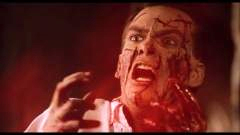 In
“The Return to Amityville" (14:51), Stern discuses adapting the original
film from Jay Anson's novel, adapting the Jones book with respect to television
standards and the budget, scouting locations – the owner of the Leacock
house exterior would not allow them to film inside and was wary of letting them
film at all because another production had trampled her rose bushes (and that
film's producer was Bernardi) – and being unaware about the additional
violence for the R-rated version. He also discusses the family nature of the
production with not only his son Jamie acting but also his wife Kandy (THE PRESIDIO)
as production designer – who erected a false flat of the Amityville house
in front of another property – and his other sons Mark and Shawn as art
director and post-production assistant respectively. “Televised Terror"
(14:28) is an interview with cinematographer Tom Richmond who notes that his
previous horror credits include HARD ROCK ZOMBIES and CHOPPING MALL, being unused
to professional film production in which the operator was separate from the
cinematographer, the lighting challenges of the interiors with their bright
walls and not having control of the colors chosen for the wardrobe which he
believed clashed within the shots.
In
“The Return to Amityville" (14:51), Stern discuses adapting the original
film from Jay Anson's novel, adapting the Jones book with respect to television
standards and the budget, scouting locations – the owner of the Leacock
house exterior would not allow them to film inside and was wary of letting them
film at all because another production had trampled her rose bushes (and that
film's producer was Bernardi) – and being unaware about the additional
violence for the R-rated version. He also discusses the family nature of the
production with not only his son Jamie acting but also his wife Kandy (THE PRESIDIO)
as production designer – who erected a false flat of the Amityville house
in front of another property – and his other sons Mark and Shawn as art
director and post-production assistant respectively. “Televised Terror"
(14:28) is an interview with cinematographer Tom Richmond who notes that his
previous horror credits include HARD ROCK ZOMBIES and CHOPPING MALL, being unused
to professional film production in which the operator was separate from the
cinematographer, the lighting challenges of the interiors with their bright
walls and not having control of the colors chosen for the wardrobe which he
believed clashed within the shots.
Released to VHS and laserdisc by Republic Pictures, AMITYVILLE 1992:
IT'S ABOUT TIME also made the rounds on television before getting the requisite
fullscreen, barebones DVD release in 2005 from Lionsgate. Vinegar Syndrome's
1080p24 MPEG-4 AVC 1.85:1 widescreen Blu-ray from a 4K scan of the original
camera shows off the deliberately unpleasant interiors to better effect than
the rubbery prosthetics. The DTS-HD Master Audio 2.0 stereo mix is a bit more
ambitious with ticking, pendulum swinging, and turning gearworks occasionally
creeping into the background of scenes to remind us of the influence of the
clock. Optional English SDH subtitles are included.

“Time Pieces" (13:30) is an interview with Randel who discusses
approaching the film as a standalone work than as a sequel, knowing producer
White at New World, and redeveloping the script with the theme of how we tend
to repeat patterns in our life. He also reveals that he met cinematographer
Taylor through Denise Di Novi who had been an executive VP at New World before
going on to produce the likes of EDWARD SCISSORHANDS and BATMAN RETURNS, and
that he could no longer afford the likes of Christopher Young (HELLBOUND: HELLRAISER
II) for the score but the composer recommended Licht (who would later score
HELLRAISER: BLOODLINE). “Clockwork" (7:29) is an interview with the
co-writer/producer Christopher DeFaria (GRAVITY) who had pitched a number of
projects to White before offering to script one of the Amityville films (he
would also script the next entry A NEW GENERATION), being on the set as producer
and recalling that the bathtub fell through the floor after they let it overflow
for several takes, and how some of the bits involving lost time required crew
to move props and furnishings around just off camera.
Released on VHS and laserdisc by Republic Pictures and on fullscreen
DVD by Lionsgate, AMITYVILLE: A NEW GENERATION gains gloss in the 4K scan of
the original camera negative, with the 1080p24 MPEG-4 AVC 1.85:1 widescreen
looking crisp, sharp, and contrasty where the older transfer looked a bit hazy
with grayish blacks in the more moodily lit scenes. Detail in facial features,
clothing, and hair also does favors for the make-up effects with one zombified
character providing a jolt. The handsome cinematography fares best her of the
set while the more interesting stereo surround mix here is well-served by the
DTS-HD Master Audio 2.0 encode. Optional English SDH subtitles are provided.
 A
NEW GENERATION is the only film in the set with an audio commentary, this one
with director Murlowski and moderated by Elijah Drenner. Murlowski reveals that
much of the film's casting had actors whose dispositions matched their characters
from Rusler's alpha male aggressiveness to Naughton's comic moral ambiguity.
He also discusses the film's theme of a pseudo-family in contrast to the usual
Amityville series families, and his feelings now about the pacing in light of
how his style has developed. Murlowski also appears in the interview “Through
the Looking Glass" (13:08) which is not redundant in that it is illustrated
throughout with video shot by him on the set that most interestingly shows how
they achieved the mirror effects entirely on the set with the help of old school
effects supervisor William Cruse who had worked on the first Amityville film.
“Malevolent Reflections" (4:32) is another interview with DeFaria
who notes how the sales of 1992 led Republic to request another sequel, getting
way from the suburban and family settings, and the contributions of cinematographer
Pfister.
A
NEW GENERATION is the only film in the set with an audio commentary, this one
with director Murlowski and moderated by Elijah Drenner. Murlowski reveals that
much of the film's casting had actors whose dispositions matched their characters
from Rusler's alpha male aggressiveness to Naughton's comic moral ambiguity.
He also discusses the film's theme of a pseudo-family in contrast to the usual
Amityville series families, and his feelings now about the pacing in light of
how his style has developed. Murlowski also appears in the interview “Through
the Looking Glass" (13:08) which is not redundant in that it is illustrated
throughout with video shot by him on the set that most interestingly shows how
they achieved the mirror effects entirely on the set with the help of old school
effects supervisor William Cruse who had worked on the first Amityville film.
“Malevolent Reflections" (4:32) is another interview with DeFaria
who notes how the sales of 1992 led Republic to request another sequel, getting
way from the suburban and family settings, and the contributions of cinematographer
Pfister.
Once again released to tape and laserdisc by Republic Pictures and
barebones fullscreen DVD by Lionsgate, AMITYVILLE DOLLHOUSE also comes to 1080p24
MPEG-4 AVC 1.85:1 widescreen Blu-ray from a 4K scan of the original camera negative
which serves Callaway's photography nicely and the prosthetics thanks to his
lighting. The macro shots of the dollhouse interiors show the amount of craftsmanship
that went into the prop but the enhanced resolution does not do much for the
demons during the climax. No complaints about the DTS-HD Master Audio 2.0 track
of an uninteresting Dolby Stereo mix. Optional English SDH subtitles are provided.
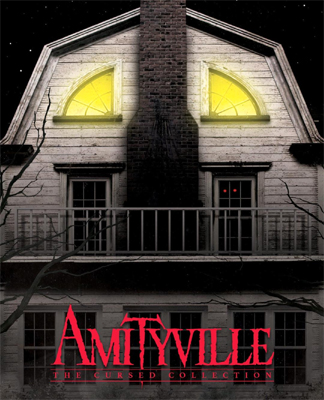 AMITYVILLE
– THE CURSED COLLECTION: AMITYVILLE 4: THE EVIL ESCAPES (1989)/AMITYVILLE
1992: IT'S ABOUT TIME (1992)/AMITYVILLE: A NEW GENERATION (1993)/AMITYVILLE
DOLLHOUSE (1996) Blu-ray
AMITYVILLE
– THE CURSED COLLECTION: AMITYVILLE 4: THE EVIL ESCAPES (1989)/AMITYVILLE
1992: IT'S ABOUT TIME (1992)/AMITYVILLE: A NEW GENERATION (1993)/AMITYVILLE
DOLLHOUSE (1996) Blu-ray









